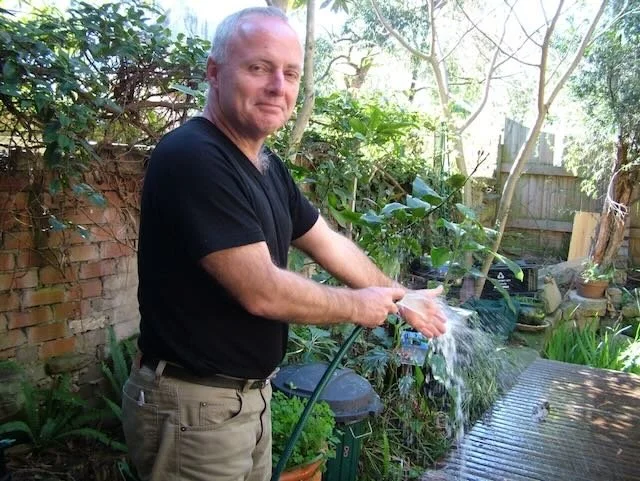• How to play with rain - it’s fun, liberating
• Me, my recycled, treated sewage, all kept in my house site these last 28 years
These playful ideas keep rain where it falls, mimic the ways rain once stayed when this catchment was natural, before we turned the trees, plants and mulch into roads and roofs.
Here’s some ways we play with rain in our Chippendale streets.
Example: Turn rain into a playful fountain
• Half the roof water from this warehouse stays here, re-directed to a fountain in a raised garden bed and adjoining garden bed
How:
· intercept a downpipe from a warehouse
• The underground pipe from the downpipe has been intercepted and re-directed to the fountain in a raised garden bed
· redirect rain to a garden bed such as this bathtub
· express, show the rain as energetic fountain water
• Fountain pipe above raised garden bed
· catch the rain to irrigate the garden in the bed
· direct overflow to irrigate the plants around the garden bed
Example: Catch rain washing off Peace Park paths, grass in a grated drain that has an open base below the grate to irrigate the adjoining garden bed
* Grate with no base diverts rain water from grass, path to adjoining plant roots in garden bed
Example: Change an underground solid drainpipe into a pipe with holes that irrigates plant and tree roots where they are - below ground
• Video - How to make a leaky drain - 2 minutes 20 seconds
Most water – about 80% - falls gently and is kept where it falls and the other 20% that comes in a rush still gets away to pollute Sydney Harbour. It’s easy to keep that 80% where it falls. When we do, life in the soil is restored and we get a lush footpath . . .
Data, drawings, details of this and similar idea are in my book, Sustainable Food.
In my house no water or sewage has left since it was disconnected from town water and sewer in 1996, 28 years ago. Over 2 million litres of rain and sewage has been kept on the site.
• Lush plant and tree growth in our footpath gardens increases property values, cool us in summer - all fed by rainwater kept where it falls
How we see, understand and use rain water depends where we are. Examples:
in the very dry city where rainfall is disappearing, Perth, Western Australia, most town water is pumped from aquifers under the city. Developers, house, unit and office buildings are obliged by the state government to keep rain on site to be absorbed and to re-charge the city’s aquifers.
In Sydney, NSW, where the town water and sewage provider, Sydney Water, is owned by the state government and is in the state’s top 15 water, energy and climate polluters, the state gets about 10% of its income from that corporatised business. The state government has a wall of red tape requiring rain water to be sent from buildings to pollute Sydney harbour and the Pacific Ocean and, like a drug dealer, to keep householders hooked on town water - there are ways around and through the red tape some of which are here.
in Adelaide, South Australia, 47% of houses have rain tanks for drinking water because the states upstream on the major water source, the Murray Darling River, steal the water and what’s left is chock full of salt, undrinkable.
These playful ideas keep rain where it falls, mimic the ways rain once stayed in Chippendale’s natural catchment before we turned the trees, plants and mulch into roads and roofs.
Playing with rain helps me to love rain, restores me, opens me up to Earth’s magic, her beauties.
How about you?
You can play with rain, too.
Michael










